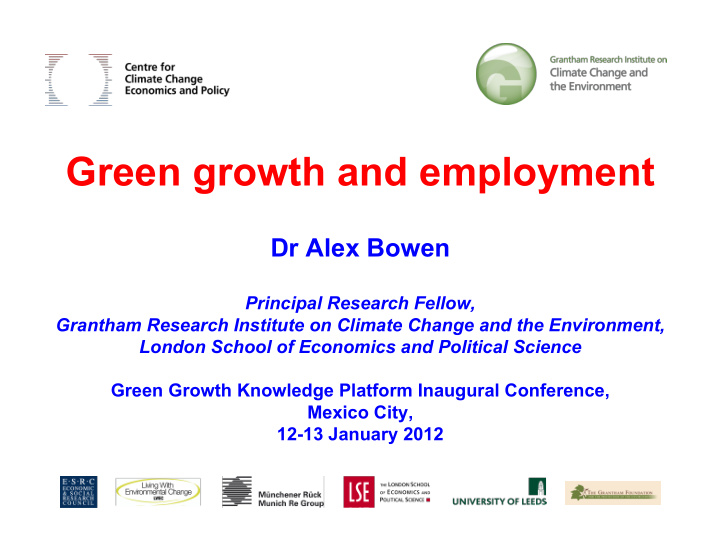



Green growth and employment Dr Alex Bowen Principal Research Fellow, Grantham Research Institute on Climate Change and the Environment, London School of Economics and Political Science Green Growth Knowledge Platform Inaugural Conference, Mexico City, 12-13 January 2012 1
Main points • ‘Green jobs’ difficult to define • Much scope for gross job creation in the transition to green growth • But policy-makers seeking co-benefits should focus on net job creation • Studies for high-income countries not necessarily a good guide for developing countries • We need to know more 2
Definitions and scope • Industry versus occupation • Scope: – Direct – Indirect – Induced: macroeconomic responses • Time horizon – Changing prices, inputs capital stock and technology – Long-term Schumpeterian growth? • Gross versus net 3
Opportunities for job creation • Green jobs around 1.7% of total paid employment in Europe (EC, 2007) on OECD/Eurostat definition of the environmental goods and services industry (OECD, 1999) • 0.25% of global employed labour force of around 1.8 bn on UNEP ‘green jobs’ definition? (UNEP,2008) • But jobs in renewables from 2.3 mn in 2006 to 20 mn in 2030? • ‘Clean energy economy’ 0.5% of US jobs (Pew, 2009) • Environment industry responsible for 1.6% of Korean employment directly and indirectly (GGGI, 2011) 4
Not all measures equally ‘jobs-friendly:’ the Korean stimulus 5
Job creation or low productivity? Source: Wei et al (2010) “Putting renewables and energy efficiency to work”
Net vs. gross: South Africa 7 Source: Rutovitz (2011), Ch. 7 in ‘The Advanced Energy [R]evolution: A Sustainable Energy Outlook for South Africa’
‘Green’ jobs: the macro context • Neoclassical full employment CGE models • Multiplier models with Keynesian unemployment – Debate about the size of the employment multiplier in different circumstances (exchange rate, Ricardian equivalence, etc) • Finance • ‘Double dividend’ – Payroll taxes 8
Costs of adjustment in labour markets 9 Source: Babiker and Eckaus (2007): ‘Unemployment effects of climate policy’
Danger of extrapolating conclusions to developing countries (1) • Less known • Uncertainty greater 10
India: wind 11 Source: TERI (2010)
Danger of extrapolating conclusions to developing countries (1) • Less known • Uncertainty greater • Starting position different • Environmental challenges greater 12
Erosion of natural capital Energy Mineral Net CO2 Particulate Total depletion depletion forest damage emissions depletion damage East 3.3 0.3 0.0 1.0 0.7 5.3 Asia/ Pacific South 2.1 0.9 0.9 0.9 0.5 5.3 Asia World 2.0 0.3 0.0 0.4 0.2 2.9 13 Source: World Bank Little Green Data Book 2011
Danger of extrapolating conclusions to developing countries (1) • Less known • Uncertainty greater • Starting position different • Environmental challenges greater • Wider variety of industrial structure • Endowments vary 14
Danger of extrapolating conclusions to developing countries (2) • Labour markets may work very differently – Segmented labour markets – Formal vs. informal sectors – Household labour supply decisions – Marginal vs. average productivity – May be more exposed to shocks to terms of trade 15
Research needs • Labour intensity of green projects in a wider range of industries over different time scales • More sophisticated macro modelling of labour markets • Better understanding of sources of labour market failures in different countries • Better understanding of the role of labour market policy interventions, including taxation, and how they interact with green policies 16
Recommend
More recommend